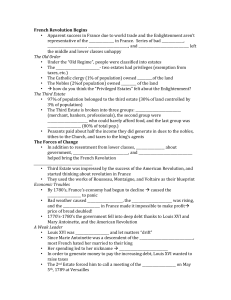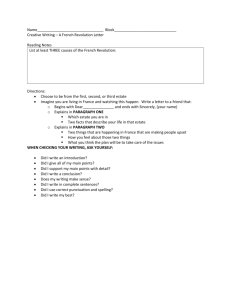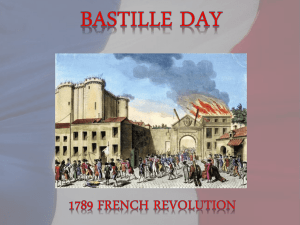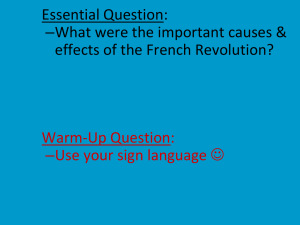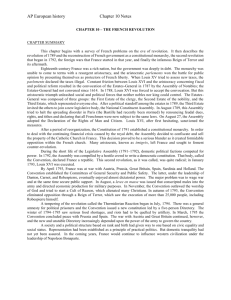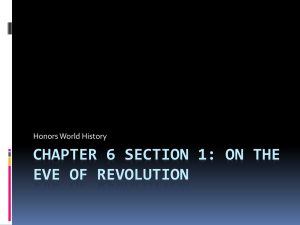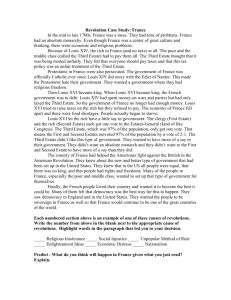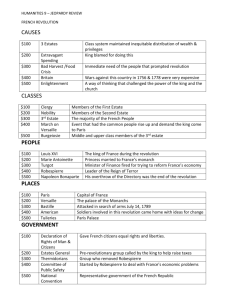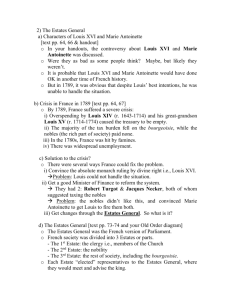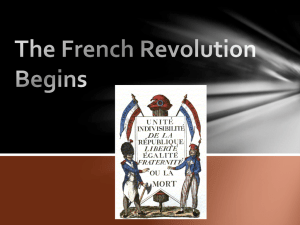FRENCH REVOLUTION -- The Story of the World -
advertisement
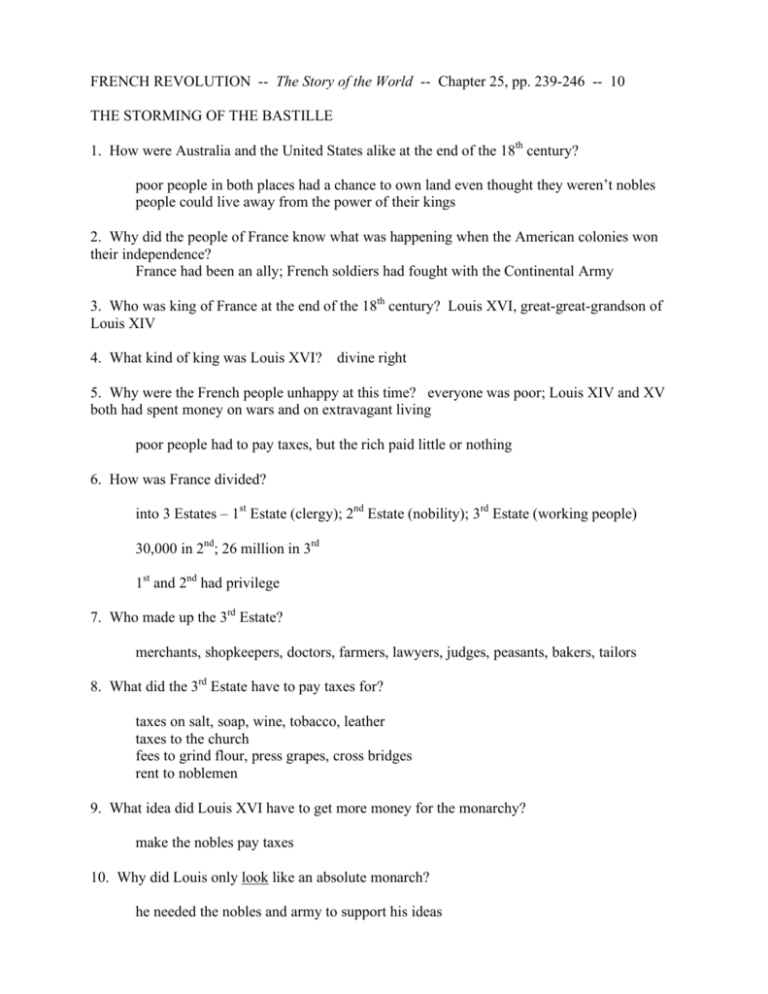
FRENCH REVOLUTION -- The Story of the World -- Chapter 25, pp. 239-246 -- 10 THE STORMING OF THE BASTILLE 1. How were Australia and the United States alike at the end of the 18th century? poor people in both places had a chance to own land even thought they weren’t nobles people could live away from the power of their kings 2. Why did the people of France know what was happening when the American colonies won their independence? France had been an ally; French soldiers had fought with the Continental Army 3. Who was king of France at the end of the 18th century? Louis XVI, great-great-grandson of Louis XIV 4. What kind of king was Louis XVI? divine right 5. Why were the French people unhappy at this time? everyone was poor; Louis XIV and XV both had spent money on wars and on extravagant living poor people had to pay taxes, but the rich paid little or nothing 6. How was France divided? into 3 Estates – 1st Estate (clergy); 2nd Estate (nobility); 3rd Estate (working people) 30,000 in 2nd; 26 million in 3rd 1st and 2nd had privilege 7. Who made up the 3rd Estate? merchants, shopkeepers, doctors, farmers, lawyers, judges, peasants, bakers, tailors 8. What did the 3rd Estate have to pay taxes for? taxes on salt, soap, wine, tobacco, leather taxes to the church fees to grind flour, press grapes, cross bridges rent to noblemen 9. What idea did Louis XVI have to get more money for the monarchy? make the nobles pay taxes 10. Why did Louis only look like an absolute monarch? he needed the nobles and army to support his ideas 11. Why was Louis’s wife, Marie Antoinette, a problem? she had nothing to do, so she spent money on stupid things and spent time on stuff like playing cards and dancing she did not know how poor the people were and that many were starving people began to dislike her 12. What impact did the Declaration of Independence have on France? translated into French; people read words about liberty and equality French people wanted those things too 13. What happened in May, 1789? representatives of all 3 estates came to Versailles to discuss taxes Estates-General – last met in 1614 14. Why did the 3rd Estate get upset during this meeting? 1st & 2nd Estates made them wear black, enter side doors – they were treated badly also king declared voting by “order” not by head 15. What action did the 3rd Estate then take? established National Assembly – June 17, 1789 – no authority to do so first step of French Revolution 16. What did the king then try to do? he locked the 3rd Estate out of their meeting room 17. What was the Tennis Court Oath? another part of first step of French Revolution June 20, 1789 – National Assembly met on an indoor tennis court and promised to meet until a new constitution was written 18. What did the common people of Paris do when they heard about the actions of the 3rd estate? went to Bastille to get weapons to help National Assembly 19. What happened on July 14, 1789? mob freed prisoners in Bastille, killed governor of prison Bastille Day – France’s independence day like July 4th for U.S. 20. Now who ruled Paris? common peasants 21. What happened to Louis XVI and his family? they were taken to a palace in Paris called the Tuileries 22. How was France now like England and America? leader would have to follow the laws and everyone was equal THE REIGN OF TERROR 23. Who led the 3rd Estate now? Maximilien de Robespierre 24. What decisions did the National Assembly make? no titles of nobility – instead everyone was called Citizen priests would be elected; priests would be paid by the government Civil Constitution of the Clergy 25. What was the result of those decisions? no more 1st and 2nd Estates – no privilege 26. What is a Royalist? someone who is loyal to the king and wants him returned to the throne 27. What was the plan of the Royalists? tried to sneak Louis XVI and his family to northern part of France to gather supporters then they would try to take back the throne 28. Why is the town of St. Menehould important? someone there recognized the king in his carriage and warned people in the next town that the king was coming – there the king was captured – the family was taken back to Paris 29. Why was Louis XVI considered a traitor? other kings in Europe threatened to invade France if Louis was harmed – people said Louis was asking other countries to invade 30. Where was Louis taken? to a dungeon called the Temple 31. What government does the National Assembly finally decide that France will be? a republic – representative democracy 32. What was the name for the National Assembly now? National Convention 33. What happened on January 21, 1793? Louis XVI beheaded 34. Why was the French Republic in trouble? other countries feared spread of revolution England, Netherlands, Spain declared war on France people loyal to Catholic priests were against National Convention dechristianization – calendar changed, churches changed 35. How did the National Convention deal with unrest inside France? appointed Committee of Public Safety – headed by Robespierre rebels (those against the Republic) were killed 36. What was the Reign of Terror? killing of anyone who sympathized with nobles, clergy, or king 37. What was the Law of Suspected Persons? anyone against the revolution, or not enthusiastic, could be executed 38. When was Marie Antoinette executed? October 16, 1793 hair pure white even though only 37 39. How many killed by Robespierre and Committee of Public Safety? 16,000 in 9 months – possibly as many as 40,000-50,000 in all 40. What happened to Robespierre? executed because of fear of his growing power – he was killing even members of National Convention National Convention afraid he would become dictator worse than Louis XVI 41. At the end of the Reign of Terror, what is the status of France’s government? no king, no leader
